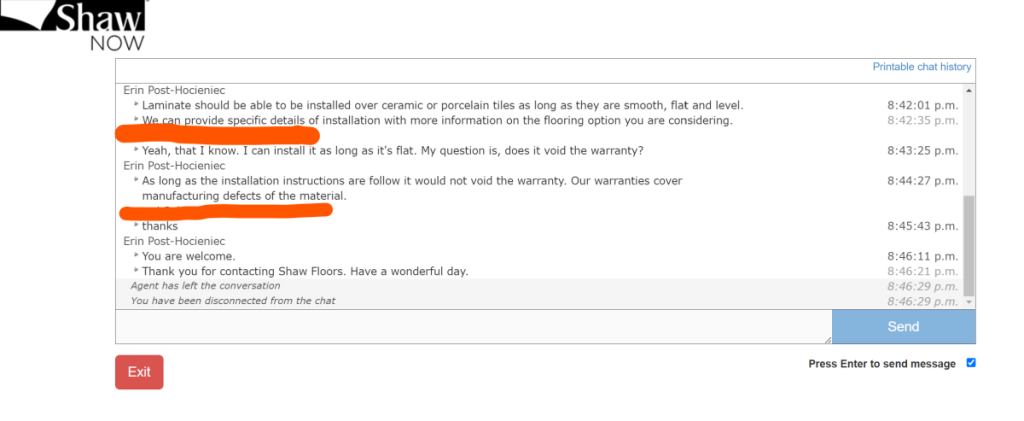If you already have tile flooring and are looking to renovate with laminate flooring, you might want to save yourself the trouble of removing all the tiles. People choose laminate flooring over tile for a variety of reasons.
- Tiles are cold. Many people find it uncomfortable to walk over it.
- Tile removal is a costly endeavor. Whether you do it yourself or hire professionals, it requires a lot of work. Further, the cost of removing tile per square foot is between $3 and $6, according to Porch. Installing laminate is therefore double the price. For this reason, people opt to install laminate flooring over tile in order to save money.
- House resale value – You can take out those floating floors and give the tile flooring to the new owners when you flip the house. Removing tiles would decrease resale value.
Yes, you can install laminate over tile floor as long as it is flat. Is it really possible to go over tiles with laminate flooring without any drawbacks?
Can you put laminate flooring over tile? – There are several serious factors to consider.
Things To Consider
Tile Conditions
First and foremost, everything lies in the current condition of the existing tiles. Laminate flooring should not be laid on tiles that are not leveled and are damaged. If the tiles have been damaged, broken, are uneven, or have any sort of complications, removing the tiles is your best bet.
If the tile is flat without any lippage, not loose or cracked, you can lay the laminate over it. Any lippage can cause the laminate flooring’s click-lock mechanism to fail. For the tiles that are not flat, you can use a leveling compound to flatten the area out and then lay the laminate on top of it. But that’ll ruin your tile. As per NLFA, the sub-floor must have a lippage no greater than 3/16″ for laminate flooring to be installed over it. That means that if the tile flooring lippage is less than 3/16″, an SLC is not required when installing laminate over tile.

Laminate Thickness
As you lay the laminate over the tiles, the height of your floors will increase. A laminate plank normally starts with 7mm thickness whereas the average tile thickness is about 3 mm. Installing laminate flooring over tile is like installing 3 layers of tile.
The only major concern is to trim down the doors to allow for the increase in height of the flooring. In addition, the jambs and casings need to be cut down. Cutting down jambs, doors, or casings is not a difficult task; however, you should make sure that you’re never going to go back to tile. You’ll have to spend more money if you don’t replace them.
In addition, laminate flooring will need an underlayment. Consider how the overall combined thickness could affect adjacent areas like the entrances, doors, cupboards, and appliances.
In a Kitchen, Can Laminate Flooring Be Put Over Tile?
In the kitchen, putting laminate over tiles is a bit challenging. A kitchen counter is just the right height for a dishwasher to fit; if the floor height is raised too much, your dishwasher will no longer fit. The same goes for ovens. If you have taken proper measurements and are confident that the increase in height will not cause any problems, you can go ahead.
Apart from this, laminate flooring in the kitchen is not a good idea. An overflowing dishwasher or faulty hose can ruin the laminate.
Will Laminate Flooring Over Tile Work in The Bathroom?
You can lay laminate flooring over bathroom tiles, same as any other room. However, make sure to choose water-resistant laminate boards to prevent them from water damage.
Underlayment
There might be a moisture barrier beneath the tile layer, and the tile layer will act as the underlayment for the laminate flooring. However, it is best to ensure that you place an underlayment on the tile to prevent damage to the laminate flooring.
The underlayment will provide warmth underfoot, acoustics, and protection against moisture. If your laminate already has an attached underlayment, there is no need to get an additional underlayment.
What About Tiles with Underfloor Heating?
Typically, laminate floor planks will absorb any heat from the underfloors. Furthermore, the underlayment will absorb any remaining heat. The maximum recommended underfloor heating temperature is 27 deg, as per nu-heat.co.uk. You can use a floor temperature sensor to measure the temperature.
Installation Method
The installation method of the laminate needs to be taken into consideration as well. Most of the time, you can use the click-lock mechanism to install the laminate floor, but there might be certain times when gluing would be necessary.
The click-lock mechanism is the standard and preferred installation method for the laminate floor. However, if you have glue-down laminate floors, it may not work very well on tiles – it would be better to remove the tiles.
Warranty
Some manufacturers, however, warn that putting laminate over tile can void the warranty of laminate planks. Ultimately, it’s up to the manufacturer. I checked a few popular manufacturers’ warranty guidelines in PDF format. I did not find any substantial evidence that laminate over tile voids the warranty in my research.
Pergo: The warranty guideline does not mention laying laminate over any other flooring.
Newton Flooring Support: They told me to conform with the retailer.

Shaw Flooring said as long as the instructions are followed, they do not have any issues.

Prior to doing this, it’s always a good idea to ask your retailer.
Now that we know that laying laminate over tile is indeed possible, the real question is – should you do it?
Should You Install Laminate Flooring Over Tiles?
When resurfacing tile flooring with laminate, you have the option to either remove the flooring and then replace it or install the laminate floor on top. Tile is a high-end flooring solution, but it is still quite hard to tear them off.
Putting laminate over tile has both pros and cons.
Pros
Not removing tiles will save money.
Ceramic tiles get cold, but the laminate floor doesn’t.
Boards made from laminate have a smooth surface. The floor feels softer when you walk barefoot.
Cons
We may have to trim doors, jambs, door casing, cupboards, etc.
Bad idea to install them in water-prone areas such as the kitchen and bathroom.
If the tile does pose any risk, such as having cracks or height issues, it would be best to remove the tiles. A broken tile floor will end up ruining your new laminate floor with moisture issues, stability issues, and the like.
Leave a Reply